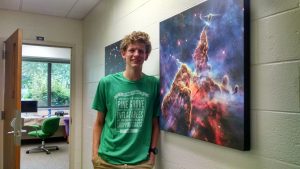 Light Curve Fitting of Fermi Normal and Millisecond Pulsars
Light Curve Fitting of Fermi Normal and Millisecond Pulsars
Research Advisor: Dr. Peter Gonthier
Since the launch of NASA’s Fermi Gamma-ray Space Telescope (Fermi), its Large Area Telescope (LAT) has detected over 200 new γ-ray pulsars. For most of these, γ-ray light curves have been obtained containing information on the emission geometry, the particle acceleration mechanism, and its location within the magnetosphere. In addition, radio astronomers have obtained radio light curves from the radio-loud Fermi pulsars, which are synchronized in time with the γ-ray light curves. Such data of observed radio and γ-ray light curves of normal and millisecond pulsars can be compared with those predicted from a hybrid model that assumes force-free electrodynamics within the light cylinder and a dissipative regime outside (FIDO) as well as empirical radio beam geometry and luminosity models. Such fits serve to constrain the viewing geometry of the pulsar by restricting the angle of the observer and the magnetic inclination angle with respect to the rotation axis. In this way the flux correction factor can be determined, enabling the estimation of the radio and γ-ray fluxes. This research will be useful in further testing of this theoretical high-energy emission model and improving our understanding of where and how the acceleration of charge is taking place in the pulsar magnetosphere.
This research was supported by an award to Hope College from the Howard Hughes Medical Institute through the Undergraduate Science Education Program and by an undergraduate fellowship from the Michigan Space Grant Consortium.

